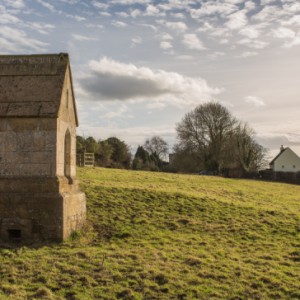Our Lady's Well, Hempsted
It was a lovely still and mostly sunny day following the wind from Storm Doris yesterday. I thought I'd combine a shopping trip to Gloucester with a visit to an old holy well which I could submit to Freespiral's 'International Holy Well Month' challenge, which ends shortly.
Helena came home just as I was leaving early in the afternoon, so she gladly jumped in the car and we headed off. I first found the well with her when she worked at a school nursery in Hempsted village right beside St Swithun's church.
The well is possible a spring and is now housed within a Cotswold stone building, which is Grade 1 Listed. The site is at the top of sloping fields with the River Severn only a couple of hundred yards away. Surprisingly it is only about two miles from Gloucester Cathedral and is on a signposted walk called the Glevum Way. I gather a Roman camp was sited just above the spring, where there are still earthworks, as well as traces of medieval ridge and furrow in the fields which haven't yet been built upon under the expansion of the modern city.
This view of the well building is looking north towards the city centre. I have added several other views to the 'Extra Photos' to show the well within the landscape, as well as a picture of the church taken on the way to the site. I won't keep these other pictures here for long. You might spot Woodpeckers taking a few minutes to lie in in the sun. She has also blipped the well.
I have seen an old photo of the well showing an old stone water trough for animals built into the ground, but it has now disappeared. It was mentioned in the details of this official Listing from January 1955.
'Well house and adjoining water trough. Well house built for the Manor of Hempsted in late C14, held by the former Augustinian Priory of Llanthony Secunda, Llanthony Road, the trough probably added in C18 or C19. Well house of ashlar with gabled roof of dressed limestone slabs, trough defined by dressed stone kerb walls. The well house a small, square building above a natural spring with entry to chamber on the east side, the rectangular water trough for stock at low level on the east side extending to north. A substantially complete, rare and important surviving example of a medieval well house.'
There is a heavily damaged scultpture high on the rear of the building, but it is hard to make out any detail. Sadly there is no water there at all now, and it seems to have been blocked when I tried to look inside through the iron gate.
This following old description of the well can be found in the article 'Some Ancient Wells, Springs and Holy Wells of the Cotswolds' by Laurence Hunt.
'The well building is a tall structure built entirely of large limestone blocks. On the west side is a small arched opening, formerly closed with an iron door. In front of the well water issues into a long stone trough. The north and south walls are plain, but in the gable of the east wall is a very worn sculpture which appears to show a large figure standing between two smaller figures. Walters quotes Canon Bazeley who suggested it may represent St Anne standing between her daughter St Mary and an angel (or perhaps her husband), arguing that the well was probably connected with the nearby priory of Llanthony on the outskirts of Gloucester. He suggests the well may once have been dedicated to St Anne, around 1136,, possibly originally deriving its name from the similarity of the sound of ‘Anne’ and ‘Wan’, implying a pre-Christian pagan well here dedicated to the god Wan (= Woden). Hope quotes the sculpture as representing the Virgin addressing a crowd. In recent times the well has always been known as Our Lady’s Well supporting Hope’s interpretation.
The well was considered to have medicinal properties until recently. Ancient earthworks survive just to the east of the field containing the well. Some form of protection from cattle would be desirable as they are begining to undermine the sides of the well when descending the bank to drink.'




Comments
Sign in or get an account to comment.


